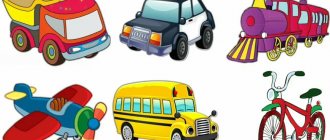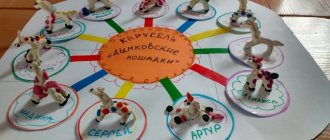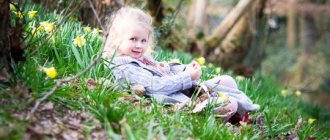Middle group. Junior preschool age. Children 4 - 5 years old
Summary of a music lesson in the middle group “Colorful walk” “Colorful walk ”
(artistic and aesthetic development, social and communicative development, cognitive development, physical development, speech development)
Program objectives : 1. Improve intonation expressiveness of speech.
2. Sing with a light sound, movingly... New Year’s decoration for the walking section of the middle group “How candy grew on our branch”
Popova Valentina New Year's decoration of the walking area of the middle group “How candy grew on our branch”
There is very little time left before the most magical and beloved holiday of the New Year. Adults and especially children look forward to this holiday...
Targeted walks and excursions; methodological development of the world around us (middle group) on the topic
Long-term plan of excursions and targeted walks
In the middle group No. 1
September
1 Tour of the kindergarten site. Introduce children to the diversity of the plant world.
2 Targeted walk around the territory of the kindergarten. Let the children understand that the territory of the kindergarten is not limited only to the area where children walk; broaden children's horizons. Activate the vocabulary: territory, flower bed, flower garden. Foster a caring attitude towards nature. Develop labor skills and abilities.
3 Targeted walk to the flower garden.
4 Targeted walk to the preparatory group site. Watch older children play. Cultivate friendly relationships. Develop conversational speech.
October
1 Excursion around the territory of the kindergarten. Develop children's skills, admire the beauty of autumn nature.
2. Targeted walk to the kindergarten park. Expand knowledge about the season - autumn, name the signs of autumn. Consider plants: trees, shrubs, herbs. Note that everything has turned yellow, “Golden Autumn” has arrived
3 Target walk “Feathered Friends”. Consider the birds and their body parts. Activate the words in speech: birds, sparrows, crows, fly, sit, jump, fly over.
4 “Grass-ant”. Note that the grass has withered, late autumn has arrived. Name the characteristic signs of autumn.
November
1 A tour of the streets where the kindergarten is located. Introduce children to the rules of safe behavior on the street. Pay attention to objects (shops, post office, clinic)
2 “We’ll go around the garden.” Consider the kindergarten building. Find group windows. Note that every house has windows, doors and their purpose.
3 “Why are fences needed?” Note with children the purpose of fences, reinforce that you cannot walk behind a fence - life safety.
4 Targeted walk to the music room. Get to know the profession of a music director. He teaches us to sing, dance, play musical instruments, and celebrates holidays. Show musical instruments and play them.
December
1 Excursion to the medical office of the kindergarten. Introduce children to the profession.
2 Target walk to a neighboring site. Introduce neighbors to children. Children's ability to communicate with older children.
3 Target walk “We’ll go around the kindergarten.” Looking at the fallen snow.
4 Target walk “Observation of transport”. Strengthen children's knowledge about types of transport (public, freight, passenger)
January
1 Walking tour. LIFE SAFETY FUNDAMENTALS.
2 Targeted walk to the senior group. Introduce children to the group room of older children. Children's ability to communicate with older children. Orientation in space.
3 Target walk to the snowdrift. Consider the snowdrift that caused it to form (accumulation of snow). Activate the words in speech: snow, blizzard, winter, snowdrift.
4 “Whose trace?” Awaken in children a sense of interest and involvement in everything they see and notice. To develop children’s ability to observe, examine and talk.
February
1 Excursion to the laundry. Introduce the profession.
2 “We will go along the path.” Create a joyful mood about the snowy buildings you see. Activate the words in children's speech: snowman, snowwoman, slide, labyrinth.
3 Target walk to the winter tree. Examine the tree, note that it is bare, there are no leaves, because it is still very cold outside.
4 Target walk “Let’s go around the garden.” Looking at the icicles on the roof. Life safety - why you can’t walk under the roofs of houses and kindergartens, reinforcing safety rules.
March
1 Excursion to the kitchen, introduce the equipment. To introduce the profession and cultivate interest in it.
2 Targeted walk around the site. Expand knowledge about the season - spring. Name the signs of spring (snow melting, the sun is warming up, buds are swelling on the trees, birds are singing like spring).
3 Observation of icicles. See the changes that happen to the icicles, the reasons for the drops. Give signs of spring.
4 "Our birds". Continue observing and examining the birds that have flown to the site.
April
1 Excursion to the birch tree. To consolidate children's knowledge that trees do not die in winter; buds remain on the branches, from which green leaves bloom. Plants need warmth to grow. To develop children’s ability to use examination techniques, to arouse interest in observing trees.
2 “Why are fences needed?” Target walk to the fence. Monitoring passing vehicles. Expand knowledge about types of transport (bus, truck, car). Activate words in children's speech: cabin, body, wheels, steering wheel.
3 Targeted walk around the site. Create a joyful mood. Draw the children's attention to the area, how it has changed. There was a lot of snow, but now it has almost all melted.
4 “Where does the puddle live?” Note why they form in the spring. Why? Encourage statements (melting snow, the sun is warming) Show children a variety of actions with melted snow.
May
1 Excursion around the territory and outside of the kindergarten. To form in children an idea of the diversity of the plant world. Develop the ability to distinguish and name familiar flowering plants. Cultivate a caring attitude towards plants.
2 Target walk to the tree. To develop children’s ability to observe, compare, see a phenomenon in its development, what happened recently, what has happened now. Add the following words to your children's active vocabulary: branch, buds, swollen, young leaves appear.
3 Targeted walk around the site. Examine the first young grass that appears. Expand knowledge about changes in nature.
4 Targeted walk to the garden. Observing the work of adults in the garden. Expand children's knowledge about plants. Show seedlings, seeds. Introduce the words: beds, seedlings, seeds, vegetable garden, watering can.
Walks. Walking notes - Observation in the middle group on a walk behind the trees: spruce, thuja
Publication “Observation in the middle group on a walk behind the trees: spruce, ...”
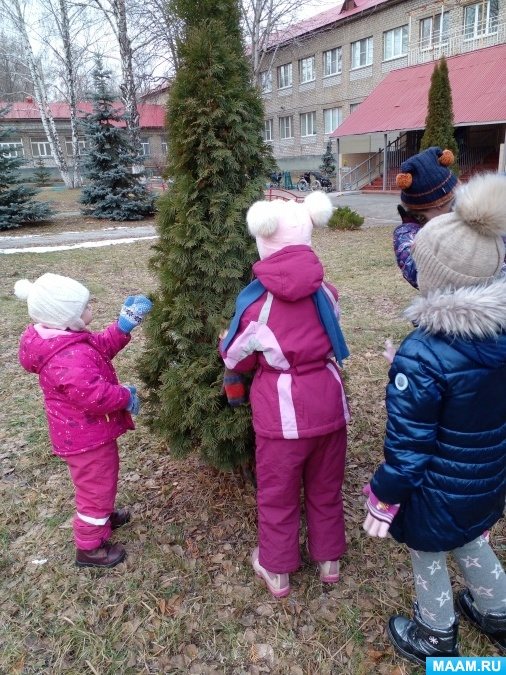
Program objectives: -Expand children's understanding of trees growing on the site (spruce, thuja); expand children's horizons and vocabulary. — Develop observation skills: find similarities and differences. -Cultivate a caring attitude towards nature. Preliminary work:...
Quest game “Help the mouse” on a walk for children of the middle group Goal: to develop interest in a new form of gaming activity (quest game) Objectives: to consolidate ideas about changes in nature, to develop social and communicative qualities through a collective decision, to consolidate counting within 3 , consolidate knowledge of geometric shapes, ability...
Summary of the lesson “Observing a walk behind a spruce tree” in the middle group
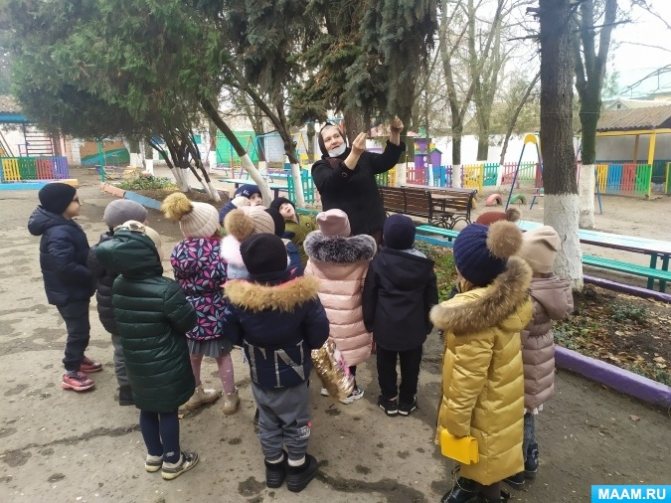
Goal: developing a value attitude towards objects of living nature using the example of a tree - spruce. Objectives: Deepen and systematize children’s knowledge about living nature. To form ideas about the appearance of coniferous trees using the example of spruce. Clarify ideas about spruce, name...
Summary of a walk with children of the middle group “Observation of leaf fall”
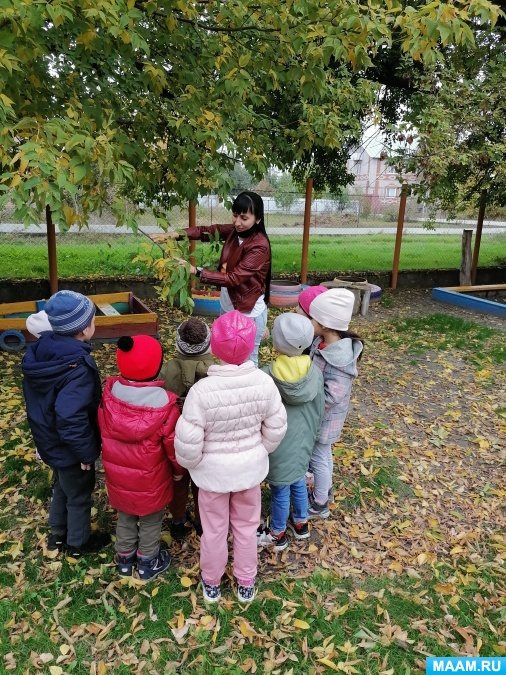
Summary of a walk with middle group children on the topic: “Observing leaf fall” Purpose: to show children that nature is beautiful in all seasons; explain that nothing happens by chance in nature: plants need fallen leaves on the ground in winter and autumn. I. Guys, look...
Lesson summary for the middle group “Autumn walk”
Lesson summary for the middle group “Autumn walk”
Educator: Sinyakova I.V.
Goals:
introduce children to the main signs of autumn: cooling, change in color of leaves on trees, falling leaves, frequent rains. Introduce the general concept of “season”. Introduce the name of the trees growing on the territory of the kindergarten. Enrich children's vocabulary.
Preliminary work:
looking at an album with pictures of trees, leaves and fruits.
Materials:
toy hare, colored pencils, A4 sheet of paper.
Progress of the lesson:
Educator: Dear children. Today we will go for a walk with the bunny. Now I will introduce you. Meet this bunny, and his name is Forget. He often forgets everything. And I would like to get to know all the trees that grow in our kindergarten. Does everyone know how to get acquainted?
Forgetful Bunny: Oh, did I forget?
Educator: Children, let's remind the bunny.
Children: Yes. First we say hello, say our name, then ask what their name is.
Forgetful Bunny: I'll try to remember. (Meet the children). Do you think trees can talk?
Children: no
Forgetful Bunny: So what should we do? How do we know the name of each tree?
Educator: Don’t worry, bunny, I understand the language of trees a little, and I will introduce you.
We approach the first tree, a birch.
Educator: And here is the first tree. Let's say hello. Who will be the first to meet? Or did you recognize this tree?
Children: found out it’s a birch tree.
Educator: Well done. How glad she is that you recognized her. Birch recognizes you all every morning; you walk past her to kindergarten. This is how joyfully its leaves rustle.
Forget the Bunny: Hello birch, and I am the Forget Bunny. What a beautiful trunk it has, white with black stripes. But, something happened, why are some of the leaves on the ground? And why did they turn yellow?
Children: Because autumn has come.
Forgetful Bunny: Autumn. Oh, what is autumn?
Educator: Autumn is the time of year. Guys, tell Zabyvayka what signs of autumn do you know and after what time of year does autumn come?
Children's answers (the leaves turn yellow and fall off, it becomes cold, cold rains often fall; autumn comes after summer).
Forgetful Bunny: How smart you are. When I return home to my mother, I will definitely tell her.
We approach the second tree, a pine.
Educator: This tree is called pine. Let's say hello too.
Forget the Bunny: Hello pine, I'm the Forget Bunny.
Children also say hello to the pine tree.
Forgetful Bunny: Why are there no leaves on the pine tree, but only needles? Maybe it's not a tree at all?
Educator: What about the bunny? A pine tree has both a trunk and branches. And instead of leaves it has needles; they do not turn yellow or fall off in the fall, but remain green. There is even a riddle about the pine tree:
Winter and summer in the same color
Forgetful Bunny: I’ll definitely remember.
Third tree, rowan.
Forgetful Bunny: And here, some kind of berries?
Children: this is a rowan.
Educator: Correctly, this tree with beautiful, red berries is called rowan.
Bunny Forget: A very beautiful name Rowan and its leaves are not yellow, but red.
Educator: Children, together with Forget, let’s say hello to the mountain ash.
Children and bunny: Hello rowan.
Educator: Forgetful, all children know how to be friends with trees.
Children are told that they should not harm trees: break branches and tear leaves from the branches.
Educator: Trees are very useful, they purify the air, provide shade and coolness in the summer when it’s hot, animals and birds feed on tree seeds. Birds also build their nests in trees. And how beautiful it is in our kindergarten territory. Especially in the fall. When the leaves of the trees turn different colors.
Forgetful Bunny: How many interesting things I learned today. But, somehow, I already want to run. Guys, let's play my favorite game “Who runs faster?”
P/i “Run to the birch tree”
goal: to develop motor activity
move: at the teacher’s signal, the children must run to the birch tree, the one who first reached the indicated tree wins.
Educator: Well, now let's collect the fallen leaves into piles, and give the brightest and most beautiful ones to the Forgetful Bunny. He will dry them, remember autumn and from which tree these leaves fell.
D/i “Whose sheet?”
Goal: to consolidate knowledge about some trees, to teach how to determine by a leaf which tree it belongs to
Progress: Children bring leaves and name what tree they come from.
Educator: Well, bunny, let us check you to see if you remember all the names of the trees we introduced you to.
The bunny names the names of the trees. Children praise the bunny Forget.
Forgetful thanks the guys and leaves.
Educator: Did you like the walk with the bunny Forget?
Children: I liked it.
The teacher asks each of the children what specifically they liked or remembered during the walk.
Educator: Come on, when we return to the group, you will draw what exactly you liked.

